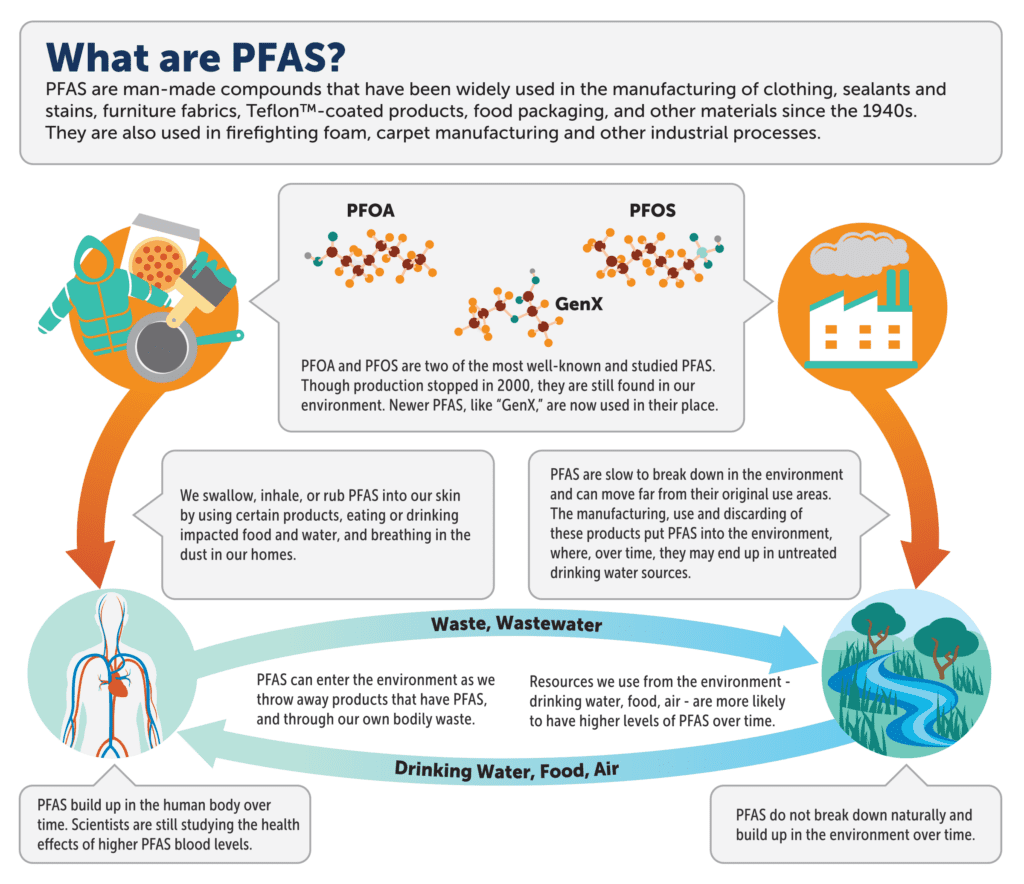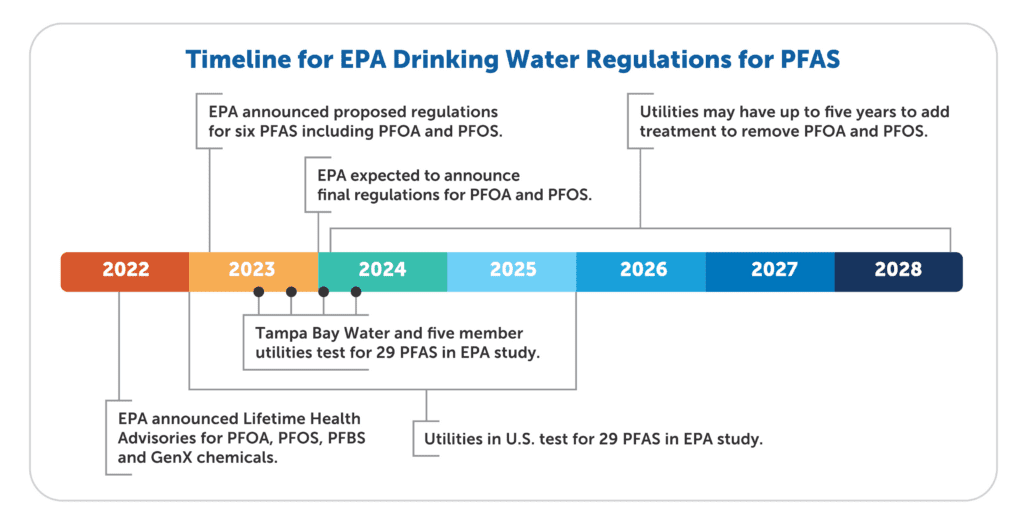Per- and Polyfluoroalkyl Substances (PFAS)
The best way to keep drinking water safe is to protect the source. Pinellas County Utilities is committed to continuously protect drinking water for everyone who lives in and visits our county.
What are PFAS?
Per- and Polyfluoroalkyl Substances (PFAS) are a family of chemicals used since the 1940s to manufacture stain-resistant, water-resistant and non-stick products. PFAS are widely used in common consumer products as coatings, like food packaging, outdoor clothing, carpets, leather goods, personal care products, cosmetics and more. Certain types of firefighting foams—historically used by the U.S. military, local fire departments, and airports to fight oil and gasoline fires—may also contain PFAS.

These substances stay in the environment for a long time because they do not break down easily. As a result, PFAS are widely detected in soil, water, air and food. People can be exposed to PFAS when they use products that contain the compounds, eat PFAS-contaminated food or drink PFAS-contaminated water. When ingested, some PFAS can build up in the body. Over time, they may accumulate to levels associated with negative health outcomes.
The U.S. Environmental Protection Agency (EPA) is focused on a small number of these compounds that may have health effects at very low concentrations, two of which are perfluorooctanoic acid (PFOA) and perfluorooctane sulfonate (PFOS).

PFAS and Public Health
Chemicals like PFAS do not originate in the Tampa Bay Water treated drinking water supply provided to Pinellas County Utilities customers. The manufacturing and use of products with PFAS puts PFAS chemicals into the environment, where, over time, they may end up in drinking water supplies.
Pinellas County Utilities delivers clean, quality tap water that meets or exceeds all federal and state standards for safe drinking water. Tampa Bay Water treatment plants are not located near industrial or manufacturing facilities known to produce PFAS materials.
What is the EPA doing?
The EPA issued interim drinking water lifetime Health Advisory levels for select PFAS in June 2022 at lower levels than previously issued in 2016. PFOA and PFOS cannot yet be reliably measured at those levels using current scientific instrumentation. The interim Health Advisories will remain in place until the EPA develops formal regulation.
In March 2023, the EPA issued proposed regulatory limits for six PFAS compounds in drinking water. The proposed limits address levels of PFOA and PFOS as individual contaminants, while the other four compounds (PFNA, PFHxS, PFBS, and Gen X) are included as a PFAS mixture.

What is Pinellas County doing?
Pinellas County Utilities is participating in the EPA’s Unregulated Contaminant Monitoring Rule 5 (UCMR5) study to evaluate concentrations of 29 unregulated PFAS compounds in drinking water supplied to our customers. This effort includes quarterly sampling and analysis of these chemicals with a total of four sampling events during a 12-month monitoring period.
PFAS compounds were not detected in drinking water samples collected in the first or second quarters at the entry point into our distribution system (results below). We will continue to update this page with sample results from subsequent quarters.
UCMR5 Results
Quarter 1 and Quater 2 results as reported in September 2023 and January 2024, respectively.
| Contaminant | Minimum Reporting Level (ug/L) | Results Q1 | Results Q2 |
| 11-chloroeicosafluoro-3-oxaundecane-1-sulfonic acid (11Cl-PF3OUdS) | 0.005 | ND | ND |
| 1H,1H, 2H, 2H-perfluorohexane sulfonic acid (4:2FTS) | 0.003 | ND | ND |
| 1H,1H, 2H, 2H-perfluorooctane sulfonic acid (6:2FTS) | 0.005 | ND | ND |
| 1H,1H, 2H, 2H-perfluorodecane sulfonic acid (8:2FTS) | 0.005 | ND | ND |
| 9-chlorohexadecafluoro-3-oxanonane-1-sulfonic acid (9Cl-PF3ONS) | 0.002 | ND | ND |
| 4,8-dioxa-3H-perfluorononanoic acid (ADONA) | 0.003 | ND | ND |
| *hexafluoropropylene oxide dimer acid (HFPO-DA)(GenX) | 0.005 | ND | ND |
| nonafluoro-3,6-dioxaheptanoic acid (NFDHA) | 0.02 | ND | ND |
| perfluorobutanoic acid (PFBA) | 0.005 | ND | ND |
| *perfluorobutanesulfonic acid (PFBS) | 0.003 | ND | ND |
| perfluorodecanoic acid (PFDA) | 0.003 | ND | ND |
| perfluorododecanoic acid (PFDoA) | 0.003 | ND | ND |
| perfluoro (2-ethoxyethane) sulfonic acid (PFEESA) | 0.003 | ND | ND |
| perfluoroheptanoic acid (PFHpA) | 0.003 | ND | ND |
| perfluoroheptanesulfonic acid (PFHpS) | 0.003 | ND | ND |
| perfluorohexanoic acid (PFHxA) | 0.003 | ND | ND |
| *perfluorohexanesulfonic acid (PFHxS) | 0.003 | ND | ND |
| perfluoro-4-methoxybutanoic acid (PFMBA) | 0.003 | ND | ND |
| perfluoro-3-methoxypropanoic acid (PFMPA) | 0.004 | ND | ND |
| *perfluorononanoic acid (PFNA) | 0.004 | ND | ND |
| *perfluorooctanoic acid (PFOA) | 0.004 | ND | ND |
| *perfluorooctanesulfonic acid (PFOS) | 0.004 | ND | ND |
| perfluoropentanoic acid (PFPeA) | 0.003 | ND | ND |
| perfluoropentanesulfonic acid (PFPeS) | 0.004 | ND | ND |
| perfluoroundecanoic acid (PFUnA) | 0.002 | ND | ND |
| N-ethyl perfluorooctanesulfonamidoacetic acid (NEtFOSAA) | 0.005 | ND | ND |
| N-methyl perfluorooctanesulfonamidoacetic acid (NMeFOSAA) | 0.006 | ND | ND |
| perfluorotetradecanoic acid (PFTA) | 0.008 | ND | ND |
| perfluorotridecanoic acid (PFTrDA) | 0.007 | ND | ND |
| *Contaminants with proposed regulatory limits | |||
| ND Non-Detect: contaminant was analyzed but not detected |
Our wholesale water provider, Tampa Bay Water, conducted its own sampling at upstream points of connection into the Pinellas County Utilities system. The results are posted here. Three of the six PFAS compounds with proposed regulatory limits were detected at these locations at concentrations well below the proposed limits.
Pinellas County Utilities strongly supports holding polluters accountable for cleaning up PFAS contamination. Working with Tampa Bay Water and the Florida Department of Environmental Protection, Pinellas County Utilities will stay current with scientific and technological updates to continue to meet all regulatory requirements.
What can you do?
- Learn more about the issue.
- Be aware of the many sources of PFAS exposure.
- If you’re concerned about exposure, you can check household product ingredient labels for compounds with “perfluoro” or “polyfluoro” in the name.
- Reach out to manufacturers of non-stick, water-resistant, and stain-resistant products for information about their contents.